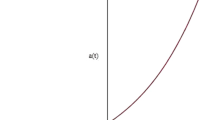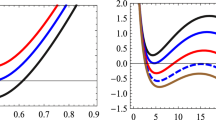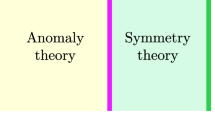Abstract
We study the thermodynamical torus partition function of superstring on the near-extremal black NS5-brane background. The exact partition function has been computed with the helps of our previous works: [arXiv:1012.5721 [hep-th]], [arXiv:1109.3365[hep-th]], and naturally decomposed into two parts. The first part is contributed from strings freely propagating in the asymptotic region, which are identified as the superstring gas at the Hawking temperature on the linear-dilaton background. The second part includes the contribution localized around the ‘tip of cigar’, which characterizes the non-extremality. Remarkably, the latter part includes massless excitations with non-vanishing thermal winding, which signifies that the Hagedorn-like behavior effectively appears, even though the Hawking temperature is much lower than the Hagedorn temperature. We also explore the high-temperature backgrounds defined by the orbifolding along the Euclidean time direction. In those cases, the thermal winding modes localized around the tip are found to be tachyonic, reflecting the singularities of Euclidean backgrounds caused by orbifolding.
Similar content being viewed by others
References
R. Hagedorn, Statistical thermodynamics of strong interactions at high-energies, Nuovo Cim. Suppl. 3 (1965) 147 [INSPIRE].
B. Sathiapalan, Vortices on the string world sheet and constraints on toral compactification, Phys. Rev. D 35 (1987) 3277 [INSPIRE].
Y. Kogan, Vortices on the world sheet and string’s critical dynamics, JETP Lett. 45 (1987) 709 [Pisma Zh. Eksp. Teor. Fiz. 45 (1987) 556] [INSPIRE].
K. O’Brien and C. Tan, Modular invariance of thermopartition function and global phase structure of heterotic string, Phys. Rev. D 36 (1987) 1184 [INSPIRE].
J.J. Atick and E. Witten, The Hagedorn transition and the number of degrees of freedom of string theory, Nucl. Phys. B 310 (1988) 291 [INSPIRE].
J.M. Maldacena and A. Strominger, Semiclassical decay of near extremal five-branes, JHEP 12 (1997) 008 [hep-th/9710014] [INSPIRE].
G.T. Horowitz and A. Strominger, Black strings and p-branes, Nucl. Phys. B 360 (1991) 197 [INSPIRE].
Y. Kazama and H. Suzuki, New N = 2 superconformal field theories and superstring compactification, Nucl. Phys. B 321 (1989) 232 [INSPIRE].
E. Witten, On string theory and black holes, Phys. Rev. D 44 (1991) 314 [INSPIRE].
G. Mandal, A.M. Sengupta and S.R. Wadia, Classical solutions of two-dimensional string theory, Mod. Phys. Lett. A 6 (1991) 1685 [INSPIRE].
I. Bars and D. Nemeschansky, String propagation in backgrounds with curved space-time, Nucl. Phys. B 348 (1991) 89 [INSPIRE].
S. Elitzur, A. Forge and E. Rabinovici, Some global aspects of string compactifications, Nucl. Phys. B 359 (1991) 581 [INSPIRE].
R. Dijkgraaf, H.L. Verlinde and E.P. Verlinde, String propagation in a black hole geometry, Nucl. Phys. B 371 (1992) 269 [INSPIRE].
T. Eguchi and Y. Sugawara, Non-holomorphic modular forms and SL(2, \( \mathbb{R} \))/U(1) superconformal field theory, JHEP 03 (2011) 107 [arXiv:1012.5721] [INSPIRE].
Y. Sugawara, Comments on non-holomorphic modular forms and Non-compact superconformal field theories, JHEP 01 (2012) 098 [arXiv:1109.3365] [INSPIRE].
D. Kutasov and N. Seiberg, Number of degrees of freedom, density of states and tachyons in string theory and CFT, Nucl. Phys. B 358 (1991) 600 [INSPIRE].
A. Giveon and D. Kutasov, Little string theory in a double scaling limit, JHEP 10 (1999) 034 [hep-th/9909110] [INSPIRE].
A. Giveon and D. Kutasov, Comments on double scaled little string theory, JHEP 01 (2000) 023 [hep-th/9911039] [INSPIRE].
T. Eguchi and Y. Sugawara, SL(2, \( \mathbb{R} \))/U(1) supercoset and elliptic genera of noncompact Calabi-Yau manifolds, JHEP 05 (2004) 014 [hep-th/0403193] [INSPIRE].
A. Hanany, N. Prezas and J. Troost, The partition function of the two-dimensional black hole conformal field theory, JHEP 04 (2002) 014 [hep-th/0202129] [INSPIRE].
D. Kutasov and D. Sahakyan, Comments on the thermodynamics of little string theory, JHEP 02 (2001) 021 [hep-th/0012258] [INSPIRE].
J. Polchinski, Evaluation of the one loop string path integral, Commun. Math. Phys. 104 (1986) 37 [INSPIRE].
V. Fateev, A.B. Zamolodchikov and A.B. Zamolodchikov, unpublished.
V. Kazakov, I.K. Kostov and D. Kutasov, A matrix model for the two-dimensional black hole, Nucl. Phys. B 622 (2002) 141 [hep-th/0101011] [INSPIRE].
K. Hori and A. Kapustin, Duality of the fermionic 2D black hole and N = 2 Liouville theory as mirror symmetry, JHEP 08 (2001) 045 [hep-th/0104202] [INSPIRE].
J.M. Maldacena, Statistical entropy of near extremal five-branes, Nucl. Phys. B 477 (1996) 168 [hep-th/9605016] [INSPIRE].
M. Berkooz and M. Rozali, Near Hagedorn dynamics of NS five-branes, or a new universality class of coiled strings, JHEP 05 (2000) 040 [hep-th/0005047] [INSPIRE].
T. Harmark and N. Obers, Hagedorn behavior of little string theories, hep-th/0010169 [INSPIRE].
Y. Nakayama, Y. Sugawara and H. Takayanagi, Boundary states for the rolling D-branes in NS5 background, JHEP 07 (2004) 020 [hep-th/0406173] [INSPIRE].
D.A. Sahakyan, Comments on D-brane dynamics near NS5-branes, JHEP 10 (2004) 008 [hep-th/0408070] [INSPIRE].
Y. Nakayama, S.-J. Rey and Y. Sugawara, D-brane propagation in two-dimensional black hole geometries, JHEP 09 (2005) 020 [hep-th/0507040] [INSPIRE].
Y. Sugawara, D-brane falling into 2D black-hole and closed string radiation, AIP Conf. Proc. 805 (2006) 374 [INSPIRE].
Y. Nakayama, S.-J. Rey and Y. Sugawara, Unitarity meets channel-duality for rolling/decaying D-branes, JHEP 08 (2006) 014 [hep-th/0605013] [INSPIRE].
D. Kutasov, D-brane dynamics near NS5-branes, hep-th/0405058 [INSPIRE].
V. Fateev, A.B. Zamolodchikov and A.B. Zamolodchikov, Boundary Liouville field theory. 1. Boundary state and boundary two point function, hep-th/0001012 [INSPIRE].
J. Teschner, Remarks on Liouville theory with boundary, hep-th/0009138 [INSPIRE].
T. Eguchi and Y. Sugawara, Conifold type singularities, N = 2 Liouville and SL(2, R)/U(1) theories, JHEP 01 (2005) 027 [hep-th/0411041] [INSPIRE].
T. Eguchi and Y. Sugawara, Modular bootstrap for boundary N = 2 Liouville theory, JHEP 01 (2004) 025 [hep-th/0311141] [INSPIRE].
W. Boucher, D. Friedan and A. Kent, Determinant formulae and unitarity for the N = 2 superconformal algebras in two-dimensions or exact results on string compactification, Phys. Lett. B 172 (1986) 316 [INSPIRE].
V. Dobrev, Characters of the unitarizable highest weight modules over the N = 2 superconformal algebras, Phys. Lett. B 186 (1987) 43 [INSPIRE].
E. Kiritsis, Character formulae and the structure of the representations of the N = 1, N = 2 superconformal algebras, Int. J. Mod. Phys. A 3 (1988) 1871 [INSPIRE].
Author information
Authors and Affiliations
Corresponding author
Additional information
ArXiv ePrint: 1208.3534
Rights and permissions
About this article
Cite this article
Sugawara, Y. Thermodynamics of superstring on near-extremal NS5 and effective Hagedorn behavior. J. High Energ. Phys. 2012, 159 (2012). https://doi.org/10.1007/JHEP10(2012)159
Received:
Accepted:
Published:
DOI: https://doi.org/10.1007/JHEP10(2012)159




